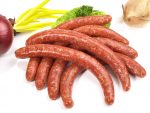Fermented sausages have been part of cultural lore have been known of for thousands of years. When meat of any sort was first dried it was not apparent to the early producers of such products that they were inadvertently performing a type of fermentation. The original developers of these fermented sausages are most likely the Chinese although it has mainly become a preserve of many European practitioners.
Most sausages are classified according to the level of dryness. The reduction in water activity is one of the main hurdles required in preservation.
The fermented sausages are classified into four main groups.
The most common type is the air-dried dry sausage which loses over 30% of its weight in moisture during the drying process. Very, very few of these sausages are ever smoked and in most cases rely not just on fermentation with bacteria but also moulds and yeasts. Good examples of such products include the genuine sausages such as salami and French saucisson. Generally, none of thee sausages are ever smoked although they may use smoked ingredients such as pimento.
Smoked sausages is another class which will have lost at least 20 per cent of its water activity. It does not rely on any growth of moulds or yeasts. A good example is the German sausage Katenrauchwurst.
One of the largest groups are the semi-dry sausages which are characterised by having less than 20% of the water activity removed. These are often smoked but with no mould or yeast growth. The ‘summer sausages’ belong to this group.
Finally, the undried spreadable fermented sausages occur which have at least 90% water activity and are often smoked. These include German Teewurst, frische Mettwurst.
Most of the dry and semi-dry sausages are prepared from cured meats which are comminuted. They rely on seasonings. As mentioned thay may be smoked or not. Examples include chorizos, cappicola, German and Italian salami, frizzes, Lebanon Bologna, pepperoni farmer cervelat and Thuringer cervelat.
Fermentation
Generally, lactic acid bacteria (LAB) and Gram-positive catalase-positive cocci (Coagulase negative Staphylococcus and Kocuria) are seen as the two main groups of bacteria that are known to be technologically important in the fermentation and drying of dry fermented sausage (.
The presence of lactic acid bacteria is to raise lactic acid levels to a pojnt where the pH of the meat emulsion becomes acidic enough to inhibit meat-borne pathogens. The acid also has a functional benefit in coagulating soluble meat proteins which reduces the water binding capacity and also eases drying of the sausage (
Staphylococcus and Kocuria are also important for colour stabilization, decomposition of peroxides, and aroma formation due to their proteolytic and lipolytic activities (Garcia-Varona et al., 2000).
Most sausages may be inoculated with a starter culture of the order of 10E6 cfus/ml. One of the issues of fermentation is uncontrolled solid-state fermentation by pathogens such as coliforms and staphylococci.
Most sausages for fermentation will be prepared as a meat batter. One such composition for a typical summer sausage was prepared by Dickson and Maxcy (1985) and illustrates the type of ingredients that might be present in products of this nature.
Typical Summer Sausage Recipe (Dickson & Maxcy, 1985).
| Ingredients | Quantity (kg) |
| Beef (20:80, fat; lean) | 9.0 |
| Pork trim (20:80 fat: lean) | 13.0 |
| sodium chloride (salt) | 0.75 |
| water | 0.5 |
| glucose | 0.5 |
| sodium ascorbate | 0.014 |
| sodium nitrite | 0.00375 |
| seasonings | 0.133 |
| Total | 24.5 (kg) |
The meat is provided by the beef and pork. The preservatives include salt and sodium nitrite. That seems counterintuitive but it helps to regulate fermentation. Glucose is the sugar added as a carbohydrate source for fermentation.
Irradiation of batters is one method used to manage pathogenic bacteria in batters and is commercially viable.
References
Dickson, J. S., & Maxcy, R. B. (1985). Irradiation of meat for the production of fermented sausage. Journal of Food Science, 50(4), pp. 1007-1009.
, , , , . (2007). Microbiological characteristics of “androlla,” a Spanish traditional pork sausage. Food Microbiol. 24 pp. 52–8. .
, , , . (2000). Characterisation of Micrococcaceae isolated from different varieties of Chorizo. Int. J. Food Microbiol. 54 pp.189–95.
. (1985). Mikrobiologische Vorgänge bei der Herstellung von Rohwurst und Rohschinken. In: Mikrobiologie und Qualitat von Rohwurst und Rohschinken. Bundensanstalt für Fleischforschung, Kulmbach , pp. 85–102.
. (2000). Utilization of microbes to process and preserve meat. Meat Sci. 56 pp. 105–15
, . (1991). Starter cultures. In: Gould GW, Russels NJ, editors. Food Preservatives. Glasgow : Blackie and Son. pp. 215–34.

Leave a Reply